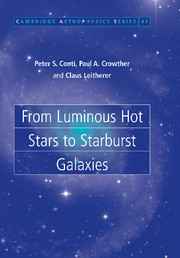Book contents
- Frontmatter
- Contents
- Preface
- Acknowledgements
- 1 Introduction
- 2 Observed properties
- 3 Stellar atmospheres
- 4 Stellar winds
- 5 Evolution of single stars
- 6 Binaries
- 7 Birth of massive stars and star clusters
- 8 The interstellar environment
- 9 From giant HII regions to HII galaxies
- 10 Starburst phenomena
- 11 Cosmological implications
- References
- Acronyms
- Symbols
- Object index
- Subject index
Preface
Published online by Cambridge University Press: 28 October 2009
- Frontmatter
- Contents
- Preface
- Acknowledgements
- 1 Introduction
- 2 Observed properties
- 3 Stellar atmospheres
- 4 Stellar winds
- 5 Evolution of single stars
- 6 Binaries
- 7 Birth of massive stars and star clusters
- 8 The interstellar environment
- 9 From giant HII regions to HII galaxies
- 10 Starburst phenomena
- 11 Cosmological implications
- References
- Acronyms
- Symbols
- Object index
- Subject index
Summary
This monograph had its origins about a decade ago when it became apparent that the field of luminous hot stars was rapidly expanding in extent and depth and connections to extragalactic astrophysics, in particular starburst galaxies, were first recognized. At that time a decade had passed since the 1988 O stars and Wolf–Rayet stars NASA monograph of Conti and Underhill. Since then, there have been far reaching advances in the astrophysics of these stars and of star-forming galaxies, both locally and at high-redshift, together with the way each affect their surroundings. On the observational side, progress interpreting the spectra of luminous hot stars allows their physical parameters to be derived with unprecedented accuracy. Studies of their ubiquitous stellar winds plus their dependence upon the element abundances has provided the impetus for revised stellar evolutionary model calculations. For the first time, additional physics, such as rotational mixing and magnetic fields, is being considered.
The advent of the Hubble Space Telescope in 1990 provided us with a UV wavelength range of greatly increased sensitivity just where most of the energy of hot stars is emitted. The use of newly commissioned 8-m ground-based telescopes has opened the door to studies of more distant hot stars in external galaxies, with different initial abundances and star formation histories compared to the Milky Way. In addition, techniques for the identification of starforming galaxies at an epoch when the Universe was as little as one tenth of its present age have been developed, and exploited with these instruments.
- Type
- Chapter
- Information
- From Luminous Hot Stars to Starburst Galaxies , pp. xi - xiiPublisher: Cambridge University PressPrint publication year: 2008

